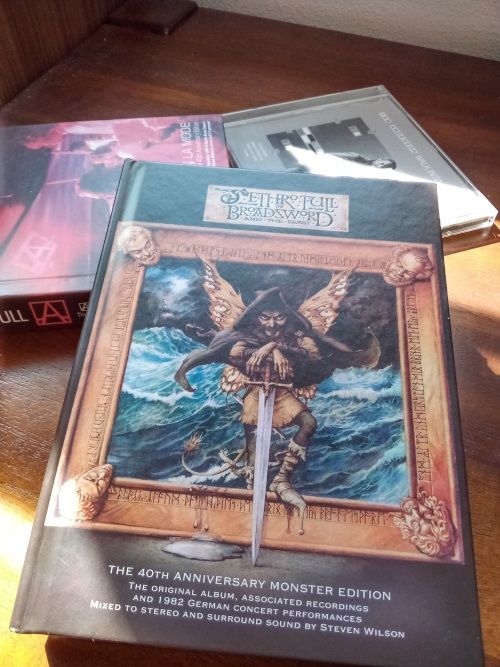I've had the new Monster Edition, i.e. - 40th Anniversary box set of Jethro Tull's The Broadsword and the Beast for a couple weeks or so now and, while I've not yet heard to the whole thing, I have listened to most of it.
A few thoughts:
Firstly, the new remix of the album is nice. I didn't notice anything dramatically different but there seems to be more space between the instruments and Dave Pegg's bass seems a bit more up front. I've always been a bit ambivalent about Gerry Conway's drum sound on the album. The snare is usually quite a bit louder than the bass drum and toms. The drums just seem off kilter. That doesn't seem to have changed with the remix.
There's an alternate version of "Cheerio" here with a bunch of people singing instead of just Ian Anderson and what I presume is a Vocoder. I really like it as has a more cheerful feel, more of a last call at the bar vibe to it.
Apparently the portative pipe organ is what we hear at the beginning of "Pussy Willow". A nice throwback to the Songs From the Wood era.
The set features multiple versions of "Fallen On Hard Times" and it is neat to hear the song evolve and be molded into the classic we know from the album. A rough mix from 1982 stands out as the more ethereal synthesizer sound is at the fore. It would later get mixed underneath a synth sound that is more squishy, less organic in nature. The song remains largely the same otherwise - it still bops along at mid-tempo - but it definitely has a different, slightly darker feel to it.
A rough mix from 1982 of "Slow Marching Band" is also really neat. For the first verse, Anderson's voice is left untreated or largely so, anyway. No double-tracking and no reverb/echo that I can hear and he sings so well and it just sounds very natural and simply gorgeous.
The album has a reputation as being one where the synthesizer technology of the early 80s meets the classic Tull sound of electric guitars, flute, and mandolin and a, forgive the pun, synthesis is achieved bringing all of the elements together in harmony. This interplay is distinct and expanded here and is thrown into really sharp relief when you consider the early 1981 sessions. It seems odd that these same sessions that produced the very folky "Mayhem Maybe" and "The Swirling Pit" (by Dave Pegg), also produced synth heavy songs such as "Too Many Too" and "I'm Your Gun". But then you have those that straddle both worlds such as "Commons Brawl", "Jack Frost and the Hooded Crow", and the previously unreleased "Inverness Sleeper" with it jaunty mandolin and synth flourishes.
It is interesting to have all of these songs together and look at the lyrics. There is some really disparate subject matter. You have something like "Jack Frost and the Hooded Crow" which asks us to consider the plight of the poor and to extend our generosity to them and then there's "The Curse", a song about a girl having her first period.
One things that sticks out is the paucity of acoustic guitar. It's like the keyboards took over that spot.
Lastly, there's a bit in the liner notes about the making of the album cover by Iain McCaig. There's a really neat early drawing of the cover when the album was still to be titled Beastie. McCaig says that Ian Anderson gave him a tape of some songs and a list of titles that he was considering for the new album. Presumably this early cover idea was the result of listening to that tape. Curiously, the track listing on the back is:
Note that "Jack-a-Lynn" features the acoustic guitar. I do think that it and "Jack Frost and the Hooded Crow" are very strong songs that should have been included on the album. The really oddity is "Crew Nights". Anderson writes of it now, "Again, it's not one of the great Jethro Tull songs." How very strange that it was apparently considered for inclusion on an album. Did he just change his mind over the years?
It is amazing at just how productive 1981-82 was for Ian Anderson. There must be 3 albums worth of songs here. Two songs, "Half Hour Video" and "Ian's Office Song" were left off as they were backing tracks only, presumably much like "Mayhem Maybe" before it was finished in 1988. Plus, there's an instrumental version of "End Game" by the band hidden away on a DVD here that would be redone for Anderson's 1983 solo album Walk Into Light. What a period of creativity!
I am beginning to reassess Peter Vettese's playing the more I listen to this material. It gets more interesting with each listen. Anderson comments that Martin Barre really became a better guitar player at this time and that he was at the height of his singing ability here and I am beginning to appreciate what he means.
But that is for another time.

No comments:
Post a Comment